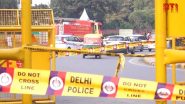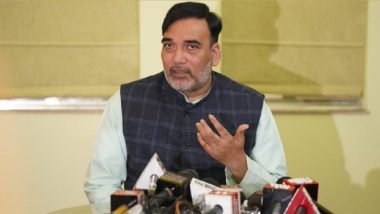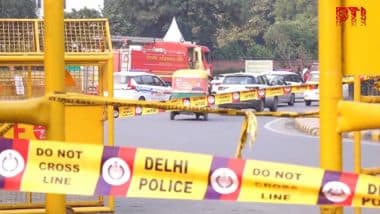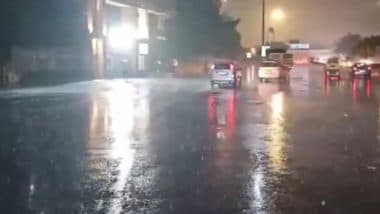New Delhi, July 17: Environment Minister Gopal Rai has said he doesn't get discouraged by studies ranking Delhi as the most-polluted capital city globally and takes it as a challenge instead.
In an interview to PTI, he said the problem of air pollution in Delhi-NCR persists despite several directions by the Supreme Court, Central Pollution Control Board, and Commission for Air Quality Management because neighbouring states are not serious about implementation. New Delhi Is World’s Most Polluted Capital City for 2nd Consecutive Year.
The minister also said the air pollution issue in the region can only be resolved through a panel of state environment ministers which should meet once every month.
"I do not get discouraged. I take it as a challenge. There are cities in India which are more polluted than Delhi. But none of them has worked on the pollution problem like Delhi has.
"Curbing air pollution is among the top 10 priorities of our government and Delhi has emerged as a fighter city," Rai said when asked about his opinion on a study ranking Delhi as the most-polluted capital city in the world.
A report released by Swiss organisation, IQAir this year had said in 2021, 22 of the world's 30 most polluted cities were in India, with Delhi being the most polluted capital city globally.
"Delhi is the first state to convert all industrial units into PNG ones and bring in a tree transplantation policy. We implemented the odd-even (car rationing) scheme when no other state had the courage to do it," he said. On the CAQM's new policy to curb air pollution in Delhi-NCR, Rai said the states need political will power to implement it properly.
"The CAQM cannot implement policies. The states have to do it. Haryana, for example, still allows diesel generator sets in certain areas that lack power supply. It has been going on for years. "We have banned firecrackers bursting in Delhi, but still people do. Where do you think these firecrackers come from?" he asked.
Thirty-one percent of Delhi's pollution is generated locally and the rest comes from neighbouring areas in the national capital region, the minister citing studies conducted by The Energy and Resources Institute and the Centre for Science and Environment in the past.
Air pollution is not Delhi's problem alone. The area in the radius of 300 kilometres of the national capital comes under a common airshed. Pollution in this range affects everyone, he said.
"We need a holistic policy and political will power to address this problem. It won't be resolved until some sort of commitment is made at the ministerial level.
"I have been demanding that a committee be constituted at the ministerial level and a joint action plan be prepared to combat air pollution in Delhi-NCR. The panel must meet once every month. Joint action is the only solution," the minister said.
Rai said he has written several letters to Union Environment Minister Bhupender Yadav stressing the need for a panel of ministers and joint action plan but "he has not even responded once".
"We have not lost hope. We need their support and we will continue to ask for it…We are not going to sit idle if the others decide not to cooperate. We will continue to take all measures to reduce our share of pollution. We are also keeping an eye on new technological solutions from around the world to curb air pollution," he said.
Rai said Delhi can even achieve the emission reduction target set under the National Clean Air Programme (NCAP) by 2024 if the neighbouring NCR cities reduce their share of pollution. "Electric buses ply inside Delhi, while diesel-run buses pollute the air on the border," he pointed out.
NCAP covers 132 non-attainment cities, which do not meet the prescribed national ambient air quality standards. The acceptable annual standard for PM 10 and PM2.5 is 60 micrograms per cubic metre and 40 micrograms per cubic metre, respectively.
In 2017, Delhi's annual PM10 average stood at 240 micrograms per cubic metre. The targeted PM 10 concentration by 2024 is 168 micrograms per cubic metre.
On the issue of stubble burning in Punjab, Rai said the AAP government in Punjab is definitely going to bring a positive change. However, it may take some time to bring the number of farm fires to zero. Punjab generates around 20 million tons of paddy straw annually.
Punjab and Haryana attract attention during the paddy harvesting season in October and November with farmers setting their fields on fire to quickly clear off the crop residue before cultivating wheat and potato. It is one of the main reasons for the alarming spike in pollution in Delhi-NCR. Asked if farmers will be fined for burning stubble in Punjab, Rai said one cannot expect the baton to resolve the issue.
On the residents opposing the expansion of the Okhla wate-to-energy plant, he said, "The plant was set up to treat waste. What if the plant itself becomes a threat to the lives of the people living nearby? There is a need to look at other options available."
Residents of several resident welfare associations had earlier written to Lieutenant Governor VK Saxena, opposing the proposal for the expansion of the WTE plant situated in the middle of residential areas. The residents have been fighting a legal battle for more than 12 years, demanding the closure or shifting of the plant from their backyards.
(This is an unedited and auto-generated story from Syndicated News feed, LatestLY Staff may not have modified or edited the content body)













 Quickly
Quickly






















